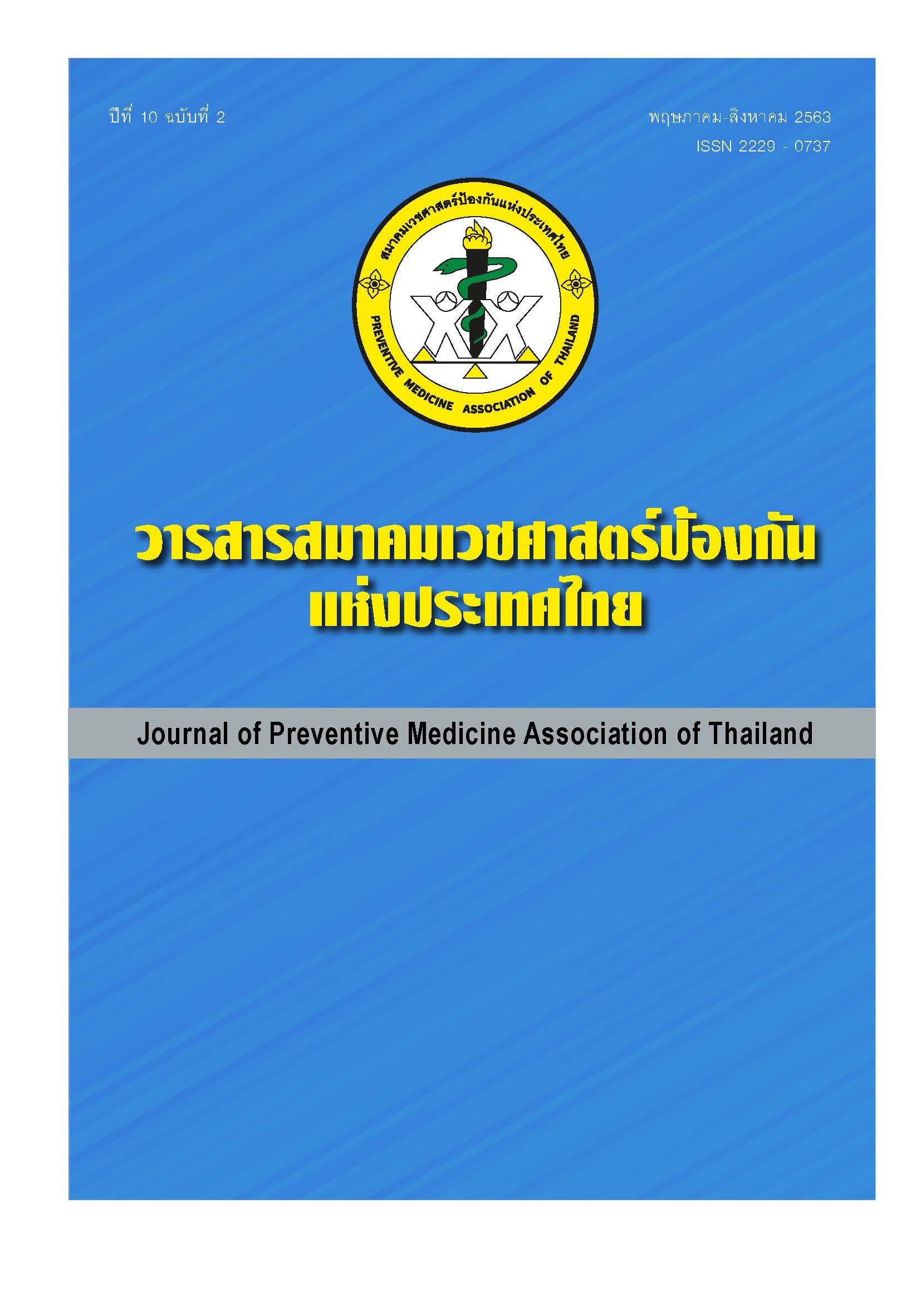Clinical Factors Predictive for Intracranial Hemorrhage in Geriatric with Traumatic Brain Injury in Chumphae Hospital
Keywords:
Intracranial Haemorrhage, Traumatic Brain Injury, GeriatricAbstract
Objective: The study aimed to determine the predictive clinical factors associated with Intracranial Hemorrhage (ICH) in geriatric patients with traumatic brain injury who visited the emergency room at Chumphae hospital Methods: A Retrospective Cross-sectional study of patients who visited the emergency room at Chumphae hospital and had received CT-Scan Brain after injured at head in 2018, a total of 217 samples. The primary outcome is predictive clinical factors as predictor of ICH in Geriatric patients with Traumatic brain injury Results: A total of 217 patients were enrolled during 2018. Incidence of intracranial hemorrhage in geriatric patients with traumatic brain injury is 21.6 %. Univariate analysis showed that ESI 2 Diabetes Mellitus(DM), Ischemic heart disease, GCS, Amnesia, LOC, Vomit >2 times, Seizure, Diminished GCS >2 points, Alcohol drinking were significantly associated with ICH and patient with DM who were associated with ICH has OR 2.9 (95%CI 1.089,7.885) Conclusion: Clinical factors which associated with ICH in geriatric patients with traumatic brain injury were ESI 2, Diabetes Mellitus (DM), Ischemic heart disease, GCS, Amnesia, LOC, Vomit>2 times, Seizure, Diminished GCS >2 points, Alcohol drinking
References
2. Faul M, Xu L, Wald MM, Coronado VG. Traumatic Brain Injury in the united states : Emergency Department visits, Hospitalizations and Deaths 2002-2006. Atlanta (GA): Centers for Disease Control and Prevention; 2010.
3. Centers for Disease Control and Prevention. Surveillance report of traumatic brain injury-related emergency department visits, hospitalizations, and deaths. Atlanta (GA): Centers for Disease Control and Prevention United States; 2014.
4. Bruns J, Hauser WA. The Epidemiology of Traumatic Brain Injury: A Review. Epilepsia 2003;2-10.
5. วิทยาลัยประสาทศัลยแพทย์แห่งประเทศไทย. แนวทางเวชปฏิบัติกรณีสมองบาดเจ็บ. กรุงเทพฯ: วิทยาลัยประสาทศัลยแพทย์แห่งประเทศไทย; 2562.
6. กรมควบคุมโรค. การบาดเจ็บทีศีรษะในผู้บาดเจ็บและเสียชีวิตจากอุบัติเหตุรถจักรยานยนต์-ผู้ป่วยใน (Admitted) ปี 2552-2554. นนทบุรี: กรมควบคุมโรค; 2554.
7. Zeng X, Pan S, Zhenbo Hu. Geriatric traumatic brain injury in China. Curr Transl Geriatr Exp Gerontol Rep 2012;1:167-70.
8. Stein DG, Cekic MM. Progesterone and vitamin D hormone for treatment of traumatic brain injury in the aged. PM R 2011;3:s100-s10.
9. Ma J, Huang S, Qin S, You C, Zeng Y. Progesterone for acute traumatic brain injury. Cochrane Database Syst Rev 2012;12(12):CD008409.
10. Thompson HJ, McCormick WC, Kagan SH. Traumatic brain injury in older adults: epidemiology, outcomes, and future implications. J Am Geriatr Soc 2006;54:1590-5.
11. Mosenthal AC, Livingston DH, Lavery RF, Knudson MM, Lee S, Morabito D, et al. The effect of age on functional outcome in mild traumatic brain injury: 6-month report of a prospective multicenter trial. J Trauma 2004;56:1042-8.
12. Isokuortti H, Iverson GL, Silverberg ND, Kataja A, Brander A, Ohman J, et al. Characterizing the type and location of intracranial abnormalities in mild traumatic brain injury. J Neurosurg 2018;129:1588-97.
13. Chaiyaporn Yuksen, Yuwares Sittichanbuncha, Jayanton Patumanond, Sombat Muengtaweepongsa, Kasamon Aramvanitch, Amornrat Supamas, et al. Clinical factors predictive for intracranial hemorrharge in mild head injury. Hindawi 2017;Article ID 5385613: 5 pages:doi.org/10.1155/2017/5385613
14. Haydel MJ, Preston CA, Mills TJ, Luber S, Blaudeau E, DeBlieux PM. Indications for computed tomography in patients with minor head injury. N Engl J Med 2000;343:100-5.
15. Thrift AG, McNeil JJ, Forbes A, Donnan GA. Risk factors for cerebral hemorrhage in the era of well-controlled hypertension. Melbourne risk factor study (MERFS) group. Stroke 1996;27:2020-5.
Downloads
Published
How to Cite
Issue
Section
License
บทความที่ลงพิมพ์ในวารสารเวชศาสตร์ป้องกันแห่งประเทศไทย ถือเป็นผลงานวิชาการ งานวิจัย วิเคราะห์ วิจารณ์ เป็นความเห็นส่วนตัวของผู้นิพนธ์ กองบรรณาธิการไม่จำเป็นต้องเห็นด้วยเสมอไปและผู้นิพนธ์จะต้องรับผิดชอบต่อบทความของตนเอง






